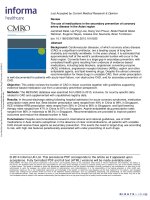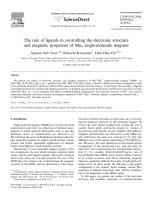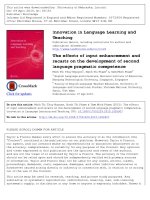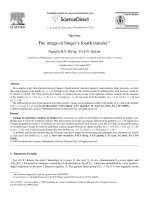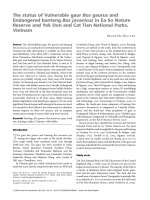DSpace at VNU: The influence of material parameters in dfb laser on generated impulse
Bạn đang xem bản rút gọn của tài liệu. Xem và tải ngay bản đầy đủ của tài liệu tại đây (1.96 MB, 6 trang )
VNU, JOURNAL OF SCIENCE. Mathematics - Physics. T XVIII, N()2 - 2002
THE
IN FLU EN C E OF M A T E R IA L
IN D F B L A S E R
ON
PARAM ETERS
GENERATED
IM P U LS E
D in h V a n H o a n g
D t'jm rtim 'ni <>l riiy s ic s . C o llccg v o f S cicn ce - V N V
Pham Van Hanh
Hrimti P o ly te ch n ic In s t itu te
1 Introduction
Distributed Fmlback lasn (DFB laser) is (>IH‘ of useful light sources generating
laser radiation vised widoly in optical communication. 1 his laser can generate longitudi
nal single 1 1 1 0 (1«* and it* wavelength is easily modulated. Especially, the DFB laser with
two (or more) sortions reveals a groat, convenience to optical communication and to all
o p tic a l transformation. Therefore, to now this laser concentrates the attention ol many
lo s r n r c h in g g r o u p s on th e w o rld a n d m a n y w orks r e la te d w ith t h i s field a r e p u b lis h e d [1-8
In this paper. vv<* would like to investigate thr influence of semiconductor material
US<*<1 for construct ion of a DFB laser with two sections oil the characteristics of generated
impulse'. Starling on I ho rate equation approximation, we have established a •systf'in
oi (’quations describing the changes of the carrier densities in tho two sections and of
I hí' laser photon density versus time, as present <‘(1 in section 2. For determining I ho
influona1 of semicondtK tor m aterial \vr notice th(' change of refraction index ot material,
and of confincinoiit factors (P eterm an coefficients) in each section. The received results
arc presented ill section 3. Finally, the* discussion and conclusions are given in section 4.
2. T h e b a s ic e q u a t io n s
A modeling schema, for a DFB laser with two sections is presented in Fig. 1.
I,
h
ÌầtCĩ
Fi gi
Hero, cell A containing actiVO medium designs active cell, but cell B having injection
current /o smaller than 11 in roll A takes a role as a saturable absorber ceil. System of
equations describing the transient operation of laser is, as in [7]:
19
D inh Van H oang , P ham Van H anh
2 0
(It
= A - - 7/1— g(u)o
eVi
n eff
- 0 J j ) r i j
~ 71 Wi,
(1)
N 2,
(2 )
dN
r = " 7 7 - r n — g {^0 -
(11
eV 2
n eff
V j ) r i j
-
72
—7 7 - = (I'l'/I + r 2//2) — <7 ( ^ 0 - Wj)(n, + 1) - 7 n 3 + ị i ự n j P ( u ) .
(it
ĩleỊf
(3)
Here N \ , No - carrier density in cells A , B \ r ij - photon density; Co, e - velocity of light in
vacuum and electric charge of electron; V i , V 2 - volume of cells -4, D \ neff - refraction index
of material is seen to 1)<> the same for two cells; ĨỊ, - amplification coefficient of each cell,
depending which on carrier density in form:
TỊ i
=
C k jN i
4*
LỈỊ,
(4)
here ( 1, ' t ị - material coefficients; 7 1 , 7 2 - relaxation coefficients of carrier density also
(lt*prii(.liug (>I) carrier density as following function:
0 1
_
BoNi
1 +
1.n
1 3 1iV
1
{B o N 2
1 -f*
»» J
jV2
w)
with
- niHtmnl coefficients; £ - saturation (oHfiruuit designing tli(* different
relaxation of crHTHT (Irnsity between two cells; F ijl’V confinement factors or Peterman
coefficients of .4, B colls, rc'sprctivoly. The relaxation coefficient of photÍ >11 7 is d(‘tm niii(i(l
by expression:
7 = — (ttttac + b a ex 4- Cờmirr).
(6 )
tteff
Here a ,/)/’ - material corffidonts; a ac,QeXia mirr- photon loss at active, absorber coll, and
through mirrors, respectively. Function c j ( u o - i j j j ) - characterizing the spectral broadening
of laser radiation has form:
» ("" = p + 4 ( ^ - u . , ) 2 =
7m * ’
171
1+ I r j
with r- tho lino width; A , = 2 /u > i)~ u )j/ - detuning coefficient.;
angular frequowy at
center of line contour and at 7 th mode. Moreover, unity in ( j i j + 1)designs t.hopresence of
spontaneous omission inlaser operation. The last factor in equation (3) notices the inter
action between external optical signal having power P { u ) with laser radiation, interaction
coefficient ị i will bo given unity in examination afterwards. System of equations (1) - ÚÍ)
is solved numerically following Runge- Kutta method and the values of all parameters ,\rv
taken following the experimental ones of Junichi Kinoshita on the basis of semiconductor
material InGaAsP |9j.
21
T h e in flu e n c e o f m a te r ia l p a r a m e te r s in
3.
T h e in f lu e n c e o f some m a t e r ia l p a r a m e te r s
In our examination, we study only the resonance case in which the generating
mode frequency u/j coincides with UJQ. Therefore function g { u>0 — u/j) = 1 . Other values
of parameters will he taken as follows: C o = 3.10 1 0 cm/s, e = l,6 10 “ 19c , V\ z= v 2 =
8.4.l ( r 9 fill3. Bo = 1 0 10. B ]
B> = 1 0 ~8 S, £ = 0 . 1 , 0 , = 0
= 4.1()-|r,, r 1
2.10 5u4,P(a/) = 10U) (p h o to n s/c m 3.s), a = 0.3, ft =
0.7, r = 17,o„,
2()()r/7i'"1 ,a mirr = 1A c m ~ l } n ef f — 3.4 for two sections
A and IỈ. The received function II ,( t ) ,from solving method indicated above, is presented
0.5, r -2
0 .2 ,/ị
' 10 2A , I o
10()r7i? " 1, (YCJ.
in fig.2a. Bv using the Fast Fourrier Transformation (FFT ) method we also have function
7 ỉ j ( u s ) given in Fi^.2b.
Kr&fl
ipR I ifciiiiiiMiii ỈM^IÉIỈÌÉ^M
:
;
rj
■ 1 M B I I I I ‘IHI..... Â
Fig.2a
(■ t i v
lijÇ’iI'ü'
Ct**vVli *
«
'
J
1;
^
s ïïi” '
v>^
'j
' 1 1 1
•I.'-' :
A'1’ .*;1 :'•&*
I»; ■■■
iliỉB Ị
Fig,2 b
All transformations of functions 7ij(t) or nj(cj) will display clearly the change of
pulse characteristics under the influence of diverse dynamical parameters .
1 . The influence of refraction index neff
In order to examine the influence» of refraction index in two cells, we choose t hree
values of n vt f ( - 3: 3.4; 4) and r o m a i n constant all other values. By the same numerical
method w<* have received different graphics of functions U j( t ) and r ij( u ỉ) which presented
in Fig. 3 and Fig.4.
D in h V an H o a n g , P h a m
Van H a n h
T h e in flu e n c e o f m a te r ia l p a r a m e te r s in
23
From these fi^uirs wc scr thfit tho pulse characteristics like* the time interval of
pulse generation A t . ! hi*
it ÌOĨ1 Yiìtt' of pulse frequency A / and the maximum valur of
the first Ị >uls«* intensify I) lire transformed as seen ill Ta hip 1.
T a b le 1
n„i
AI
Af
I,(in a.u.)
3.0
0.11x10*5
3.3G H z
1.8x10“’
3.4
0.12x1 (V s
3 GHz
1.9x1 O'"
4.0
0 .1 6 x 1 0 ks
2.2H z
.......
4.7x10'"
2. The influrncr of IYterman coefficient Ti in cell A.
In this case wo have taken three values of r x (= 0.3:0.5;0.G). Repeating the analo
gous method of calculation, till' obtained results about the change of pulse characters are
presented 111 Table 2.
T a b le 2
r,
At
Af
I,(in a.u.)
0.3
0.15x1 (Vs
2.0G H z
0.85.x I O'"
0.5
0 . 12x 10HS
3.0G H z
1.90x10'°
0 .6
0. lOx 10 Ns
3.5G H z
2 .1 0 x 1 0 ’"
3. The influence of Peterman coefficient T 2 in cell D.
We have given r *2 throe values as r 2 = 0.1;0.2;0.3. The results, that are deduced
from graphics of functions ĩ ĩ j ( t ) and Tij(üj). also display the transformation of pulse char
acters as presented in Tttblo 3.
T a b le 3
r.
At
Af
I, (in a.u.)
0.1
0 .10x10 "s
3.0G H z
2 .6 x 1 0 ’°
0.2
0 .1 1 X10 Ss
3 .0G H z
1.9x1 o'"
0.3
0 .1 2 x1 0 -*s
3.0G H z
1.4x10-°
4. Discussion and conclusions
From the changes of graphics of functions 7i j ( t ) yT ij( u ) like from the values in the
Tables we can reveal some interesting remarks:
1.
The augmentation of refraction index of semiconductor material in two sections
results in the incroasr of pulse intensity I \ like of time interval of pulse generation A £,
hut frequency r e p e t i t i o n rate A / is decreased. This means that for caçh semiconductor
material of constructing DFB laser, one need choose the suitable value of refraction index
in order to benefit both the frequency repetition rate as well as the pulse intensity.
D inh Van H oang y P ham Van H anh
24
2. Peterman coefficients in two sections have contrary influence on pulse characters.
The increase of this coefficient in section A (i.e. the increase of r ị) leads to the decrease of
time interval of pulse generation and the increase of pulse intensity, while the augmentation
of r 2 in section Ỉ Ì leads to the increase and decrease of corresponding quantities cited
above. In other words, the role of these Peterman coefficients is opposite. Therefore*,
choosing apprgpriate injection currents for two sections will be an important problem
in the use of DFB laser with two sections in optical communication. This character of
Peterman coefficients is also seen in the stationary operation of DFB laser [7].
3. It is necessary to notice that, all graphics of functions n j ( t ) } rij(u j) received hero •
is deduced from parameter values given above. Clearly, they don’t display stable pulses for
a long time (some ten ns). This also means that used parameter values are not preferable.
However, tilo change of pulse characters indicated here still reveals the influence of material
parameter in the use of DFB laser with two sections in all optical transformation.
References
1 . h : Wenzel et al., I E E E J . Q E , Vol. 32, 1(1996). p 69.
2 . B. Sartorius et al., I E E E J. Q E . Vol. 33, 2(1997), p 2 1 1 .
3.
4.
5.
6.
7.
G. Mort hier.. I E E E J. Q E , Vol. 33, 2(1997), p 231.
J.D. Freeze et al., I E E E J . Q E , Vol 33, 8(1977), p 1253.
K. Otsuka et al., Phys. Rev. A Vol. 60, 5(1999), p 3389.
Siao-Lung Hwong et al., O p tics Letters,V ol. 25, 9(2000), p 646.
Dinh Van Hoang et al., M o d e m Problem s in O ptics a n d Spectroscopy . Torn. II,
(2 0 0 0 .) p 406.
9. Junichi Kinoshita., I E E E J . Q E , Vol. 30\ (1994), p 929.
TẠP CHÍ KHOA HỌC ĐHQGHN, Toán - Lý. T.xvm, Số 2 - 2002
ẢNH H U Ở N G C Ủ A C Á C T H A M s ố VẬT LIỆU
T R O N G LA ZE DFB LÊN X U N G P H Ấ T
Đinh Vùn Hoàng
Khoa Vật lý, Dại học Khoa học T ự nhiên - ĐHQG Hà Nội
Phạm Vân Hạnh
Trường Đại học Bách Khoa Hà Nội
Trong bài báo này đã được tim thấy ảnh hường của một số thamsố vật liệu như hệ
số Peterman» chiết xuất chất bán dản... lên các đặc trưng của xungphát, khi dựa vào lời
giải bằng số theo phương pháp Runge - Kutta, của hệ phương trình mỏ tả sự hoạt động
khống dừng của một DFB laser 2 ngăn .





